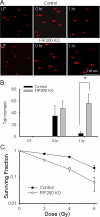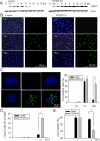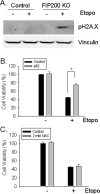Suppression of autophagy by FIP200 deletion impairs DNA damage repair and increases cell death upon treatments with anticancer agents
- PMID: 21807966
- PMCID: PMC3175275
- DOI: 10.1158/1541-7786.MCR-11-0098
Suppression of autophagy by FIP200 deletion impairs DNA damage repair and increases cell death upon treatments with anticancer agents
Abstract
Autophagy is a lysosomal bulk degradation process for intracellular protein and organelles. FIP200 (200 kDa FAK-family interacting protein) is an essential component of mammalian autophagy that is implicated in breast cancer in recent studies. Here we show that inactivation of FIP200 resulted in deficient repair of DNA damage induced by ionizing radiation and anticancer agents in mouse embryonic fibroblasts (MEF). The persistent DNA damage correlated to increased apoptosis and reduced survival of FIP200 knockout (KO) MEFs after treatments with camptothecin (CPT), a topoisomerase I inhibitor and chemotherapeutic agent. Reexpression of FIP200 in FIP200 KO MEFs restored both efficient DNA damage repair and cell survival. Furthermore, knockdown of the increased p62 expression in FIP200 KO MEFs rescued the impaired DNA damage repair and CPT-induced cell death. In contrast, treatment of cells with N-acetyl cysteine did not affect these defects in FIP200 KO MEFs. Finally, FIP200 KO MEFs also showed deficient DNA damage repair and increased cell death compared with control MEFs, when treated with etoposide, a topoisomerase II inhibitor and another anticancer agent. Together, these results identify a new function for FIP200 in the regulation of DNA damage response and cell survival through its activity in autophagy and suggest the possibility of FIP200 or other autophagy proteins as a potential target for treatment to enhance the efficiency of cancer therapy using DNA damage-inducing agents.
©2011 AACR.
Figures







Similar articles
-
Suppression of autophagy by FIP200 deletion inhibits mammary tumorigenesis.Genes Dev. 2011 Jul 15;25(14):1510-27. doi: 10.1101/gad.2051011. Genes Dev. 2011. PMID: 21764854 Free PMC article.
-
Suppression of autophagy by FIP200 deletion leads to osteopenia in mice through the inhibition of osteoblast terminal differentiation.J Bone Miner Res. 2013 Nov;28(11):2414-30. doi: 10.1002/jbmr.1971. J Bone Miner Res. 2013. PMID: 23633228 Free PMC article.
-
p62/SQSTM1 synergizes with autophagy for tumor growth in vivo.Genes Dev. 2014 Jun 1;28(11):1204-16. doi: 10.1101/gad.237354.113. Genes Dev. 2014. PMID: 24888590 Free PMC article.
-
Topoisomerase degradation, DSB repair, p53 and IAPs in cancer cell resistance to camptothecin-like topoisomerase I inhibitors.Biochim Biophys Acta. 2013 Jan;1835(1):11-27. doi: 10.1016/j.bbcan.2012.09.002. Epub 2012 Sep 21. Biochim Biophys Acta. 2013. PMID: 23006513 Review.
-
Autophagy in DNA damage response.Int J Mol Sci. 2015 Jan 23;16(2):2641-62. doi: 10.3390/ijms16022641. Int J Mol Sci. 2015. PMID: 25625517 Free PMC article. Review.
Cited by
-
Genetic inhibition of autophagy promotes p53 loss-of-heterozygosity and tumorigenesis.Oncotarget. 2016 Oct 18;7(42):67919-67933. doi: 10.18632/oncotarget.12084. Oncotarget. 2016. PMID: 27655644 Free PMC article.
-
The Challenge of Developing Autophagy Inhibition as a Therapeutic Strategy.Cancer Res. 2016 Oct 1;76(19):5610-5614. doi: 10.1158/0008-5472.CAN-16-0722. Epub 2016 Sep 15. Cancer Res. 2016. PMID: 27634767 Free PMC article.
-
Autophagy in cancer: moving from understanding mechanism to improving therapy responses in patients.Cell Death Differ. 2020 Mar;27(3):843-857. doi: 10.1038/s41418-019-0474-7. Epub 2019 Dec 13. Cell Death Differ. 2020. PMID: 31836831 Free PMC article. Review.
-
Involvement of proapoptotic genes in autophagic cell death induced by irradiation.Cell Death Discov. 2017 Dec 4;3:17068. doi: 10.1038/cddiscovery.2017.68. eCollection 2017. Cell Death Discov. 2017. PMID: 31098300 Free PMC article.
-
Role of the Exocyst Complex Component Sec6/8 in Genomic Stability.Mol Cell Biol. 2015 Nov;35(21):3633-45. doi: 10.1128/MCB.00768-15. Epub 2015 Aug 17. Mol Cell Biol. 2015. PMID: 26283729 Free PMC article.
References
Publication types
MeSH terms
Substances
Grants and funding
LinkOut - more resources
Full Text Sources
Other Literature Sources
Molecular Biology Databases
Research Materials
Miscellaneous

